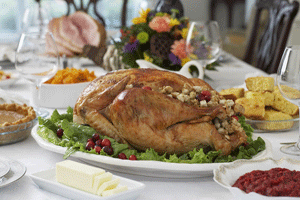Food Safety Tips for Preparing Your Thanksgiving Turkey – Advice from the Doctors at South Tampa Immediate Care
 Thanksgiving is a day for feeling thankful with family and friends, watching football, and enjoying a massive feast, including pumpkin pie and that all-important turkey! Even though it is relatively easy, preparing a turkey is something that many cooks – even the most seasoned chefs – do only a few times each year. Even home-living titan Martha Stewart has experienced problems resulting from the improper handling of a raw turkey. As such, if you’re doing the honors at your Thanksgiving feast, you’ll want to be sure to avoid an undercooked bird and the potential food-borne illness that can result. By following these simple but important guidelines, you can ensure that your turkey is not only delicious, but also safe for consumption:
Thanksgiving is a day for feeling thankful with family and friends, watching football, and enjoying a massive feast, including pumpkin pie and that all-important turkey! Even though it is relatively easy, preparing a turkey is something that many cooks – even the most seasoned chefs – do only a few times each year. Even home-living titan Martha Stewart has experienced problems resulting from the improper handling of a raw turkey. As such, if you’re doing the honors at your Thanksgiving feast, you’ll want to be sure to avoid an undercooked bird and the potential food-borne illness that can result. By following these simple but important guidelines, you can ensure that your turkey is not only delicious, but also safe for consumption:
- Fresh turkey – If you opt for a fresh bird, keep in mind that it can be kept in the refrigerator for up to two days maximum before cooking. Set the turkey in a pan, in its original packaging, to capture any juices that could leak out and contaminate produce or other food in your refrigerator.
- Frozen bird – Before buying a frozen turkey, make sure you have enough room to store it in your freezer.
- Thawing – Proper thawing is key to food safety. It is critical to keep the outside temperature of the bird below 41 degrees, because most dangerous pathogens cannot thrive in this environment. While you can defrost a turkey in a microwave or pan of cool water, the easiest way to maintain the required temperature is to use the refrigerator – just remember that this takes time (approximately 24 hours for every 4-5 pounds of turkey). It is also possible to cook a frozen turkey, but this option requires about 50 percent more time than cooking a thawed bird.
- Preparation for cooking – Wash your hands often and make sure all work surfaces, plates, and utensils are clean. Do not wash the turkey; this is not only unnecessary, but also dangerous because bacteria can spread by splashing onto other food and surfaces. Remove any giblets from the turkey cavity and cook them separately, if desired.
- Baking – Don’t rely on the turkey’s pop-up temperature indicator. Instead, use a food thermometer to make sure every part of the turkey, including the thickest portion of the breast and the innermost parts of the thighs and wings, reaches a minimum internal temperature of 165 degrees, which will effectively eliminate salmonella bacteria.
- Leftovers – The key to safely storing leftovers is getting them to that magical 41 degree mark. Cut the meat off the bones and place it in multiple zip lock plastic bags in one layer lining a refrigerator shelf. This will allow cool air to circulate quickly, leaving the turkey ready for scrumptious sandwiches and snacks in the days to come.
For more advice on how to keep yourself and your family healthy, not just during the holidays but throughout the entire year, be sure to review our online series of health articles. If you have any questions, please contact or visit the South Tampa Immediate Care walk-in clinic.












